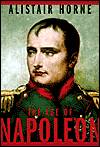Book
Review:
The Age of Napoleon
By
Alistair Horne
 To
get an idea what it was like to live during the times of the Napoleonic
Era, those interested in the period should have a look at Alistair
Horne's fascinating book The Age of Napoleon.
To
get an idea what it was like to live during the times of the Napoleonic
Era, those interested in the period should have a look at Alistair
Horne's fascinating book The Age of Napoleon.
It
isn't a large book, just over 180 pages, but it is packed with
details and stories that show France between 1796 and 1815 in
a very different way.
There
is so much information in there I have read it twice already and
it is one of those books you will keep picking up and finding
something new in.
One of the great things about The Age of Napoleon is Horne's
journalistic style, which is straightforward and well written.
He
calls a spade a spade and while it seems he has little time for
Napoleon the man, he respects some of his achievements.
For
example he says as a rebuttal to folk who compare Napoleon with
Hitler. "In terms of civil, non-military accomplishments, Hitler
after 12 years in power bequeathed to Germany nothing but a mountain
of skulls and rubble. Napoleon, on the other hand, had he never
fought a single battle, would still have to be rated one of history's
great leaders for the system of administration and civil reforms
he left behind him in France."
And
it is on the social and civil part Napoleon played in France that
Horne has focused. He has 10 major parts to The Age of Napoleon
that cover every aspect of his period in power.
They
include his rise, his loves, the master builder, style by decree,
the pleasures of empire and his fall.
The
three areas that particularly grabbed my attention were The Master
Builder, Style by Decree and The Pleasures of Empire.
Wanting
to make Paris the most beautiful city in the world, Napoleon threw
his energy into cleaning it up and redesigning it. He was not
gentle about it at times - demolishing older houses with draconian
decisions - and he was obsessed by providing the city with clean
water.
It is hard to imagine the Paris of today being a rather squalid
place, but before Napoleon it still had open sewers and took his
will to build a 60-kilometre canal to channel fresh water to the
capital.
In
Style by Decree, Horne tells how the decorative arts flourished
under the emperor, with manufacturers of fabrics and linens, as
well as silversmiths doing very nicely indeed.
His
Empire style of furniture - simple and solid - followed Napoleon's
own tastes as did his patriarchal move towards limiting the excesses
of the Directory's social habits.
He,
through the example of Josephine, changed the fashions from the
see-through, near naked dresses to more modest and moral items
of clothing.
One
of the great mental pictures in this chapter is where Napoleon
- always cold in a Paris winter - is described as being "seen
constantly wielding a pair of fire-tongs; or, in the early morning,
working with a handkerchief tied around his head, its two corners
flopping on to his shoulders".
In
The Pleasures of Empire there are some wonderful tales of the
riotous behaviour at the opera, including where rival gangs would
back their own favourites and try to end the careers of their
opponents.
And
how Napoleon would demand changes to what was showing only hours
before the performance - even if that meant people didn't know
their lines.
There
are just too many great little anecdotes to be touched on in a
review, but needless to say The
Age of Napoleon is one of those
books that fans of the Napoleonic Era should have in their home
libraries. It offers a different, civilian view of life under
Napoleon and because of this adds so much more breadth to our
understanding of the times.
-
Richard Moore
9/10